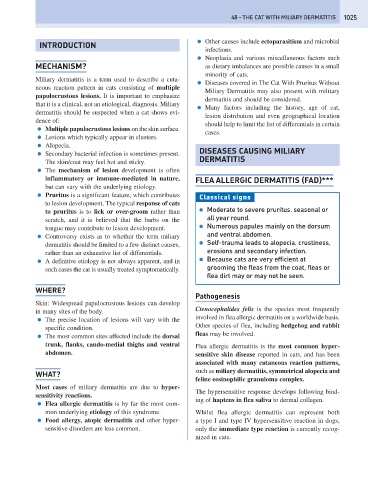Page 1033 - Problem-Based Feline Medicine
P. 1033
48 – THE CAT WITH MILIARY DERMATITIS 1025
● Other causes include ectoparasitism and microbial
INTRODUCTION
infections.
● Neoplasia and various miscellaneous factors such
MECHANISM? as dietary imbalances are possible causes in a small
minority of cats.
Miliary dermatitis is a term used to describe a cuta-
● Diseases covered in The Cat With Pruritus Without
neous reaction pattern in cats consisting of multiple
Miliary Dermatitis may also present with military
papulocrustous lesions. It is important to emphasize
dermatitis and should be considered.
that it is a clinical, not an etiological, diagnosis. Miliary
● Many factors including the history, age of cat,
dermatitis should be suspected when a cat shows evi-
lesion distribution and even geographical location
dence of:
should help to limit the list of differentials in certain
● Multiple papulocrustous lesions on the skin surface.
cases.
● Lesions which typically appear in clusters.
● Alopecia.
DISEASES CAUSING MILIARY
● Secondary bacterial infection is sometimes present.
DERMATITIS
The skin/coat may feel hot and sticky.
● The mechanism of lesion development is often
inflammatory or immune-mediated in nature, FLEA ALLERGIC DERMATITIS (FAD)***
but can vary with the underlying etiology.
● Pruritus is a significant feature, which contributes
Classical signs
to lesion development. The typical response of cats
● Moderate to severe pruritus, seasonal or
to pruritus is to lick or over-groom rather than
scratch, and it is believed that the barbs on the all year round.
● Numerous papules mainly on the dorsum
tongue may contribute to lesion development.
● Controversy exists as to whether the term miliary and ventral abdomen.
● Self-trauma leads to alopecia, crustiness,
dermatitis should be limited to a few distinct causes,
rather than an exhaustive list of differentials. erosions and secondary infection.
● Because cats are very efficient at
● A definitive etiology is not always apparent, and in
such cases the cat is usually treated symptomatically. grooming the fleas from the coat, fleas or
flea dirt may or may not be seen.
WHERE?
Pathogenesis
Skin: Widespread papulocrustous lesions can develop
Ctenocephalides felis is the species most frequently
in many sites of the body.
involved in flea allergic dermatitis on a worldwide basis.
● The precise location of lesions will vary with the
Other species of flea, including hedgehog and rabbit
specific condition.
fleas may be involved.
● The most common sites affected include the dorsal
trunk, flanks, caudo-medial thighs and ventral Flea allergic dermatitis is the most common hyper-
abdomen. sensitive skin disease reported in cats, and has been
associated with many cutaneous reaction patterns,
such as miliary dermatitis, symmetrical alopecia and
WHAT?
feline eosinophilic granuloma complex.
Most cases of miliary dermatitis are due to hyper-
The hypersensitive response develops following bind-
sensitivity reactions.
ing of haptens in flea saliva to dermal collagen.
● Flea allergic dermatitis is by far the most com-
mon underlying etiology of this syndrome. Whilst flea allergic dermatitis can represent both
● Food allergy, atopic dermatitis and other hyper- a type I and type IV hypersensitive reaction in dogs,
sensitive disorders are less common. only the immediate type reaction is currently recog-
nized in cats.

